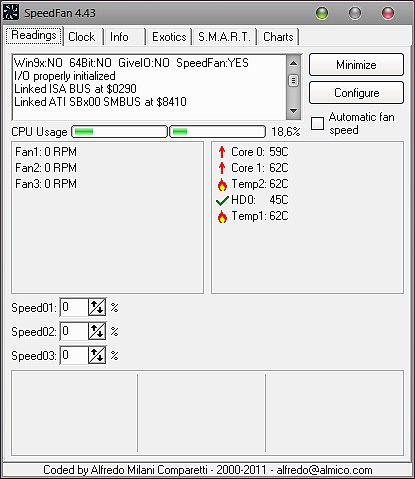
- CPU TEMPERATURE FAN GEEK TOOLS SCRIPT HOW TO
- CPU TEMPERATURE FAN GEEK TOOLS SCRIPT INSTALL
- CPU TEMPERATURE FAN GEEK TOOLS SCRIPT CODE
Each data pair consists of a double time value and a float sensor value, or a total of 12 bytes. In the background, the app will continue to accumulate new data on each timer tick, but the chart won't change until you re-check the box. If you want to freeze the chart display, uncheck this box.
CPU TEMPERATURE FAN GEEK TOOLS SCRIPT HOW TO
Also note that values on all x-axes line up-more on how to do that later.īy default, the Update Continuously box is checked, which means that during each timer tick sent by the OHM data tree (see App for CPU Temps, Fan Speeds, etc.), any new data available will be added to the chart. Note that there is one chart for each type of sensor, with all sensors of that type displayed on the same plot. This is also how the dialog will appear when opened with sensors already selected for tracking. In the image below, I checked all of the Temperature and Fan sensors, then closed the selection pane: right-click on the selection pane and click on the Close Selection menu item.check the boxes for the sensors you want to track,.The selection pane is on the right and it contains a check box for each sensor being monitored-those selected earlier in the Select Sensors dialog. When you select the View> History menu item, the History Tracking dialog opens, and if no sensors are being tracked, then it appears with the selection pane open as illustrated here: To accommodate the new features, I added two sub items to the main context menu View item, History and Alarm Log, as illustrated here: Adding visual indicators to the sensor widgets to warn that a sensor has triggered an alarm.Storing an alarm log for sensors that operate outside acceptable thresholds, and.Background recording and tracking of a sensor's history.There, I describe all the basic features and configuration settings, while in this article, I will only be discussing the new features developed here: To understand the basic functions of the app and how to configure it, go back to the previous article, App for CPU Temps, Fan Speeds, etc.

CPU TEMPERATURE FAN GEEK TOOLS SCRIPT INSTALL
You can also copy the salient executables and DLLs out of the bin/Release directory and use them, though I do believe you must install the appropriate.
CPU TEMPERATURE FAN GEEK TOOLS SCRIPT CODE
You should be able to download the code file, unzip it, load it into VS, and compile and execute it. It includes OpenHardwareMonitorLib.dll version 0.8.0 Beta. The code is implemented as a Visual Studio 2015 self-contained project. Since either one is a major undertaking, and both together are twice that, I thought it best to include their addition here in a separate article. So in addition to the ability to track and graph a sensor's history, I decided to add an automatic alarm log that records alarm events. If I was in another room when I heard the submarine dive claxon shrieking at me, by the time I got to my computer, the alarm had ended, and I didn't know which sensor had triggered it. I also occasionally got an alarm for one or more sensors. Microsoft's chart control includes a zoom feature, but it is extremely non-intuitive, buggy and sadly deficient. And given that I might be looking at several hours of data at 1 sample per second (3600 samples/hr.), I would need the ability to zoom into the graph data by selecting an area with the mouse.

To diagnose the situation, I wanted to look at a plot of the reported fan speeds over time. I really don't want to have to replace the mobo. It also occurred to me that it might not be the fan that was failing, but rather the fan speed sensor built into the motherboard, which jacked up my fear index quite a bit. As I mentioned there, the app alerted me to the fact that I had a CPU fan that was operating intermittently, and possibly failing. It includes the ability to set maximum and minimum thresholds which, when exceeded, ring an alarm to warn that a component is operating outside its acceptable range.
In a previous article, App for CPU Temps, Fan Speeds, etc., I developed a minimalist app to fully exploit OpenHardwareMonitorLib.dll (referred to here as OHM) to monitor temperatures, fan speeds, etc.


 0 kommentar(er)
0 kommentar(er)
